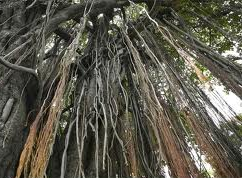
SCP-1158
Arboreal Jellyfish Puppeteers

SCP-1158's feeding and detection polyps, camouflaged within natural vines, awaiting prey
Special Containment Procedures
The 14 8 specimens of SCP-1158 in captivity are housed at Site 19, Hazardous Lifeforms Wing, in a 50m x 50m x 10m Lexan enclosure containing a rainforest habitat transplanted from its natural surroundings. Habitat temperature will be maintained at 30° C; embedded misting systems will regulate humidity levels at 70%. Full-spectrum retractable sensor pods are embedded at 10m intervals in a grid pattern throughout the enclosure to observe behavior and feeding. The enclosure will be accessed through a positive pressure airlock for enclosure and habitat maintenance. Said maintenance will be performed weekly by a team of three Level 1 personnel equipped with Tyvek exposure suits with scent-masking apparatus, accompanied by six MTF operatives armed with standard-issue M1014 shotguns. Open flames are forbidden within SCP-1158's habitat. Feeding of SCP-1158 will occur once every 21 days. Prey item will consist of one (1) live adult pig sheep (Ovis aries).
Atmospheric molecular analysis systems are to be mounted throughout the habitat to detect the chemical markers of SCP-1158 gamete deposits; all gamete deposits are to be collected for research. Gamete deposits not used in research are to be incinerated. No breeding experiments are currently authorized.
Description
SCP-1158 is an airborne, carnivorous arboreal predator superficially resembling a very large olive-drab Portuguese man-o-war (Physalia physalis), particularly in its colonial polyp attributes. Known habitat currently consists of deciduous rainforest within a 500km radius surrounding ████████, ████████. Research on deceased specimens has shown that SCP-1158’s large, four (4) meter pneumatophore is filled with hydrogen (thought to result from bacterial decay), providing lift. While airborne, SCP-1158 nestles itself high in the canopy layer, allowing its feeding and detecting polyps to hang down through the understorey to the forest floor. These polyps are effectively camouflaged among the various vines and branches present. The dactylozooid polyp bundles are, to a limited degree, prehensile. SCP-1158 has not been observed at an altitude greater than the canopy emergent layer, seemingly preferring to remain silently hidden beneath the foliage.
Prey appears limited, so far, to mammals and lizards with a mass of approximately 50kg or greater. Once a victim makes contact with dactylozooid polyps lying on the ground or adjacent to a tree, nematocysts in the polyp strands inject a paralyzing neurotoxin while nearby polyp threads wrap around the victim's extremities.
Addendum:: For reasons which have not yet been determined, all species of pig (genus Sus) tested thus far have proven to be completely unaffected by SCP-1158's neurotoxin.
Experimentation indicates that envenomation and envelopment take approximately 6 seconds. At this time, primary feeding polyps enter the victim's body through all available orifices, and anchor themselves inside. Once anchored, powerful digestive enzymes are delivered which break down internal organs for absorption by the polyps. The process has been observed to last approximately 4 days, with the victim expiring approximately 2 days after capture.
During the digestion and absorption process, if a captive subject is approached by other large vertebrates, it will stand on its hind legs and wave its front legs; if the captive subject is a human, this will produce a 'beckoning' effect.
Specimens of SCP-1158 were first discovered on █/█/20██, approximately 400km from ███, ██████, during deforestation operations pursuant to the construction of the █████ █████ and ██████ near the ███████ River. Two days after several advance parties went missing, subsequent search teams located two party members seemingly at rest near the buttresses of a large Ceiba tree. The two subjects were initially unresponsive, then appeared to be “waving” the search teams over for assistance; when approached, it was observed the two subject’s arms were suspended by “very thin vines that were making them move”. As the search team's medical personnel moved to assist, team members began stepping on and making contact with feeding polyps from several specimens of SCP-1158 hovering nearby, at which point the specimens attacked, resulting in 11 casualties. Subsequent newspaper reports garnered the attention of the Foundation, which then moved to have the area quarantined. 14 specimens were taken into custody.
Incident 1158-e3
On ██/██/20██, 14 days after SCP-1158 specimens were placed in their habitat at Site 19, a domestic pig (Sus scrofa) was introduced into the habitat to serve as a prey item. After several minutes of exploring the habitat, the pig became ensnared in SCP-1158's dactylozooid polyps as expected, but remained unaffected by SCP-1158's neurotoxin. Instead, the pig chewed through the polyps, severing them; the pig then seized the remaining polyps in its mouth and used them to pull SCP-1158 specimens from their arboreal canopy, at which point it trampled them to death and fed upon their remains. 6 specimens were lost before the pig was shot.
